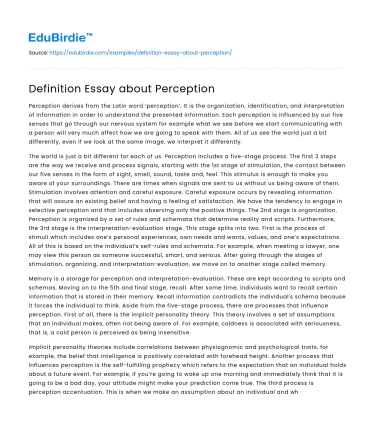Perception derives from the Latin word ‘perception’. It is the organization, identification, and interpretation of information in order to understand the presented information. Each perception is influenced by our five senses that go through our nervous system for example what we see before we start communicating with a person will very much affect how we are going to speak with them. All of us see the world just a bit differently, even if we look at the same image, we interpret it differently.
The world is just a bit different for each of us. Perception includes a five-stage process. The first 3 steps are the way we receive and process signals, starting with the 1st stage of stimulation, the contact between our five senses in the form of sight, smell, sound, taste and, feel. This stimulus is enough to make you aware of your surroundings. There are times when signals are sent to us without us being aware of them. Stimulation involves attention and careful exposure. Careful exposure occurs by revealing information that will assure an existing belief and having a feeling of satisfaction. We have the tendency to engage in selective perception and that includes observing only the positive things. The 2nd stage is organization. Perception is organized by a set of rules and schemata that determine reality and scripts. Furthermore, the 3rd stage is the interpretation-evaluation stage. This stage splits into two. First is the process of stimuli which includes one’s personal experiences, own needs and wants, values, and one’s expectations. All of this is based on the individual’s self-rules and schemata. For example, when meeting a lawyer, one may view this person as someone successful, smart, and serious. After going through the stages of stimulation, organizing, and interpretation-evaluation, we move on to another stage called memory.
Save your time!
We can take care of your essay
- Proper editing and formatting
- Free revision, title page, and bibliography
- Flexible prices and money-back guarantee
Memory is a storage for perception and interpretation-evaluation. These are kept according to scripts and schemas. Moving on to the 5th and final stage, recall. After some time, individuals want to recall certain information that is stored in their memory. Recall information contradicts the individual's schema because it forces the individual to think. Aside from the five-stage process, there are processes that influence perception. First of all, there is the implicit personality theory. This theory involves a set of assumptions that an individual makes, often not being aware of. For example, coldness is associated with seriousness, that is, a cold person is perceived as being insensitive.
Implicit personality theories include correlations between physiognomic and psychological traits, for example, the belief that intelligence is positively correlated with forehead height. Another process that influences perception is the self-fulfilling prophecy which refers to the expectation that an individual holds about a future event. For example, if you’re going to wake up one morning and immediately think that it is going to be a bad day, your attitude might make your prediction come true. The third process is perception accentuation. This is when we make an assumption about an individual and whatever we see that may contradict it we don’t take note of it and keep thinking about what we first had thought. Primacy-recency also influences perception. The primacy effect is when you remember things that are at the beginning of a list, you remember them because that is where you started. On the other hand, the recency effect is the finish. Some formulate a perception in the first few minutes they start speaking with the person and some on the last few minutes.
Furthermore, consistency influences perception as well. It is very similar to perception accentuation. We consistently view the person the same way without giving the opportunity to change our perception. Finally, stereotyping. Even though there are multiple processes that influence perception, there are ways to make perception more accurate. One has to be critical of socializing forces. From our early years, we are influenced to think like our close relatives. This may lead to negative patterns of self-perception. For example, cultural influences related to identities can lead to wry self-perceptions. Also, it helps by checking your perceptions. This can be done by describing what you see. One has to be aware that their own description is influenced by who you are. One has to think descriptively not evaluatively. Another way is to ask the other person for confirmation. Furthermore, one has to be culturally sensitive. You can increase your accuracy by being sensitive to different beliefs, values, and attitudes. You’ll witness different styles, clothing, and hairstyles. We may seem familiar with one another, but in reality, we are very different. For example, in some cultures one has to marry someone who speaks a different language, if he marries someone speaking the same language would be seen as an offensive act.
On a final note, as discussed in my assignment we can conclude that perception is a fundamental key to both organizations and individuals. Organizations have to have a good perception as it influences how they approach their customers and on what basis they produce their products or support. If they have the wrong perspective they would most probably encounter a lack of clients which also relates to individuals. For example, if an individual has the wrong perception of an individual he will most probably start the encounter with the other individual on a bad note which could’ve not been the case.






 Stuck on your essay?
Stuck on your essay?

